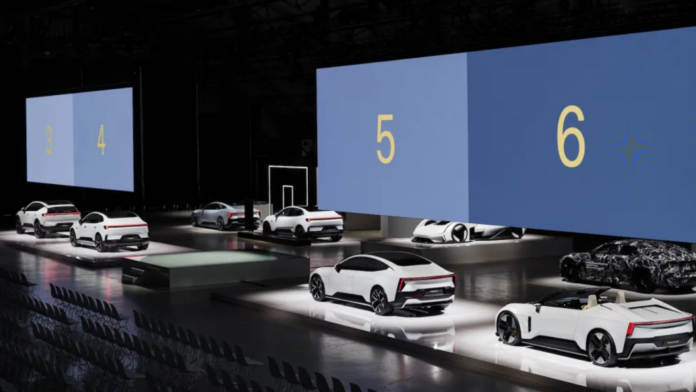Polestar, the Swedish electric vehicle company owned by China’s Geely Holdings, recently unveiled its vision for the future amidst a challenging EV market. The company’s strategy involves new technology and next-generation vehicles aimed at stimulating sales and driving growth.
The event, named ‘Polestar Day,’ held in Los Angeles, was more than just a showcase. It was a statement of resilience and innovation against the backdrop of revised delivery targets and financial challenges. Despite announcing a need for an additional $1.3 billion in funding, Polestar’s message was clear: the future is bright and within reach.
CEO Thomas Ingenlath’s interview highlighted the company’s focus on an ‘innovation melange.’ This approach encompasses the entire future lineup, including the Polestar 3, 4, 5, Precept, Electric Roadster Concept, and the Synergy. The array of upcoming models, combined with advancements in fast charging, automated driving, and vehicle-to-grid technology, positions Polestar as a versatile player in the EV market.
However, the company faces significant headwinds. The luxury EV segment is experiencing slower adoption rates, compounded by economic uncertainties and geopolitical tensions. Polestar, with its single model – the Polestar 2 – in the U.S. market, faces an uphill battle.
The focus is now squarely on the Polestar 3 and 4. Ingenlath expressed confidence in these models as key to achieving profitability by 2025. The Polestar 3, with U.S. deliveries starting in early 2024, and the Polestar 4 entering production soon, are seen as the pillars of Polestar’s future.
Attendees at the event experienced first-hand the potential of these vehicles. The Polestar 3, positioned as a luxurious and spacious SUV, boasts a digital cockpit and air suspension for a smooth ride. The Polestar 4, on the other hand, offers a unique SUV-coupe experience with innovative design choices like the absence of a rear window, enhancing passenger comfort without compromising style.
But it’s not just about the vehicles. Polestar’s partnerships in technology, like with Luminar and Mobileye, are crucial. These collaborations are set to enhance the driving experience with advanced driver assistance systems and automated driving capabilities.
One of the highlights was the partnership with StoreDot, an Israel-based battery company. This collaboration focuses on ‘extremely fast charging’ technology, aiming to revolutionize EV charging times. StoreDot’s pouch cell batteries promise an 80% charge in under eight minutes, a game-changer for EV efficiency and convenience.
The company is also exploring vehicle-to-grid (V2G) technology, with pilot projects in Sweden and California. This technology, still in its early stages, could transform EVs into mobile energy solutions, contributing back to the grid and enhancing sustainable energy practices.
Despite the challenges, Polestar’s path forward is marked by optimism and strategic planning. Ingenlath’s confidence in weathering the current market conditions speaks volumes about the company’s resilience and commitment to innovation.
In conclusion, Polestar’s strategy in these changing times is a blend of technological advancement, bold new models, and strategic partnerships. As the EV market evolves, Polestar’s agility and forward-thinking approach could well set it apart in the race for sustainable mobility.










